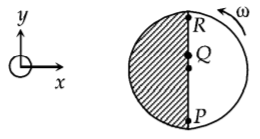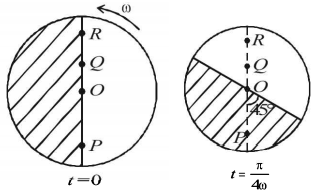221. If vectors $$A = \cos \omega t\,\hat i + \sin \omega t\,\hat j$$ and $$B = \cos \frac{{\omega t}}{2}\,\hat i + \sin \frac{{\omega t}}{2}\,\hat j$$ are functions of time, then the value of $$t$$ at which they are orthogonal to each other, is
A
$$t = \frac{\pi }{{4\omega }}$$
B
$$t = \frac{\pi }{{2\omega }}$$
C
$$t = \frac{\pi }{\omega }$$
D
$$t = 0$$
Answer :
$$t = \frac{\pi }{\omega }$$
222. A stone is projected horizontally with a $$5\,m/s$$ from the top of a plane inclined at an angle $${45^ \circ }$$ with the horizontal. How far from the point of projection will the particle strike the plane?
A
$$5\sqrt 2 \,m$$
B
$$11\sqrt 2 \,m$$
C
$$12\sqrt 2 \,m$$
D
$$15\sqrt 2 \,m$$
Answer :
$$5\sqrt 2 \,m$$
223. A particle is projected at $${60^ \circ }$$ to the horizontal with a kinetic energy $$K.$$ The kinetic energy at the highest point is-
A
$$\frac{K}{2}$$
B
$$K$$
C
Zero
D
$$\frac{K}{4}$$
Answer :
$$\frac{K}{4}$$
224.
A jet plane flying at a constant velocity $$v$$ at a height $$h = 8\,km,$$ is being tracked by a being tracked by a radar $$R$$ located at $$O$$ directly below the line of flight. If the angle $$\theta $$ is decreasing at the rate of $$0.025\,rad/s,$$ the velocity of the plane when $$\theta = {60^ \circ }$$ is :

A
$$1440\,km/h$$
B
$$960\,km/h$$
C
$$1920\,km/h$$
D
$$480\,km/h$$
Answer :
$$960\,km/h$$
225. A stone falls freely under gravity. It covers distances $${h_1},{h_2}$$ and $${h_3}$$ in the first 5 seconds, the next $$5$$ seconds and the next $$5$$ seconds respectively. The relation between $${h_1},{h_2}$$ and $${h_3}$$ is
A
$${h_1} = \frac{{{h_2}}}{3} = \frac{{{h_3}}}{5}$$
B
$${h_2} = 3{h_1}\,{\text{and}}\,\,{h_3} = 3{h_2}$$
C
$${h_1} = {h_2} = {h_3}$$
D
$${h_1} = 2{h_2} = 3{h_3}$$
Answer :
$${h_1} = \frac{{{h_2}}}{3} = \frac{{{h_3}}}{5}$$
226.
Consider a disc rotating in the horizontal plane with a constant angular speed $$\omega $$ about its centre $$O.$$ The disc has a shaded region on one side of the diameter and an unshaded region on the other side as shown in the figure. When the disc is in the orientation as shown, two pebbles $$P$$ and $$Q$$ are simultaneously projected at an angle towards $$R.$$ The velocity of projection is in the $$y-z$$ plane and is same for both pebbles with respect to the disc. Assume that $$\left( i \right)$$ they land back on the disc before the disc has completed $$\frac{1}{8}$$ rotation, $$\left( {ii} \right)$$ their range is less than half the disc radius, and $$\left( {iii} \right)$$ $$\omega $$ remains constant throughout. Then-

A
$$P$$ lands in the shaded region and $$Q$$ in the unshaded region.
B
$$P$$ lands in the unshaded region and $$Q$$ in the shaded region.
C
Both $$P$$ and $$Q$$ land in the unshaded region.
D
Both $$P$$ and $$Q$$ land in the shaded region.
Answer :
Both $$P$$ and $$Q$$ land in the unshaded region.
227. The velocity of projection of a body is increased by $$2\% .$$ Other factors remaining unchanged, what will be the percentage change in the maximum height attained?
A
$$1\% $$
B
$$2\% $$
C
$$4\% $$
D
$$8\% $$
Answer :
$$4\% $$
228.
From a balloon moving upwards with a velocity of $$12\,m{s^{ - 1}},$$ a packet is released when it is at a height of $$65\,m$$ from the ground. The time taken by it to reach the ground is
$$\left( {g = 10\,m{s^{ - 2}}} \right)$$
A
$$5\,s$$
B
$$8\,s$$
C
$$4\,s$$
D
$$7\,s$$
Answer :
$$5\,s$$
229. A car is moving along a straight road with a uniform acceleration. It passes through two points $$P$$ and $$Q$$ separated by a distance with velocity $$30\,km/h$$ and $$40\,km/h$$ respectively. The velocity of the car midway between $$P$$ and $$Q$$ is
A
$$33.3\,km/h$$
B
$$20\sqrt 2 \,km/h$$
C
$$25\sqrt 2 \,km/h$$
D
$$0.35\,km/h$$
Answer :
$$25\sqrt 2 \,km/h$$
230. A boy can throw a stone up to a maximum height of $$10\,m.$$ The maximum horizontal distance that the boy can throw the same stone up to will be
A
$$20\sqrt 2 \,m$$
B
$$10\,m$$
C
$$10\sqrt 2 \,m$$
D
$$20\,m$$
Answer :
$$20\,m$$


